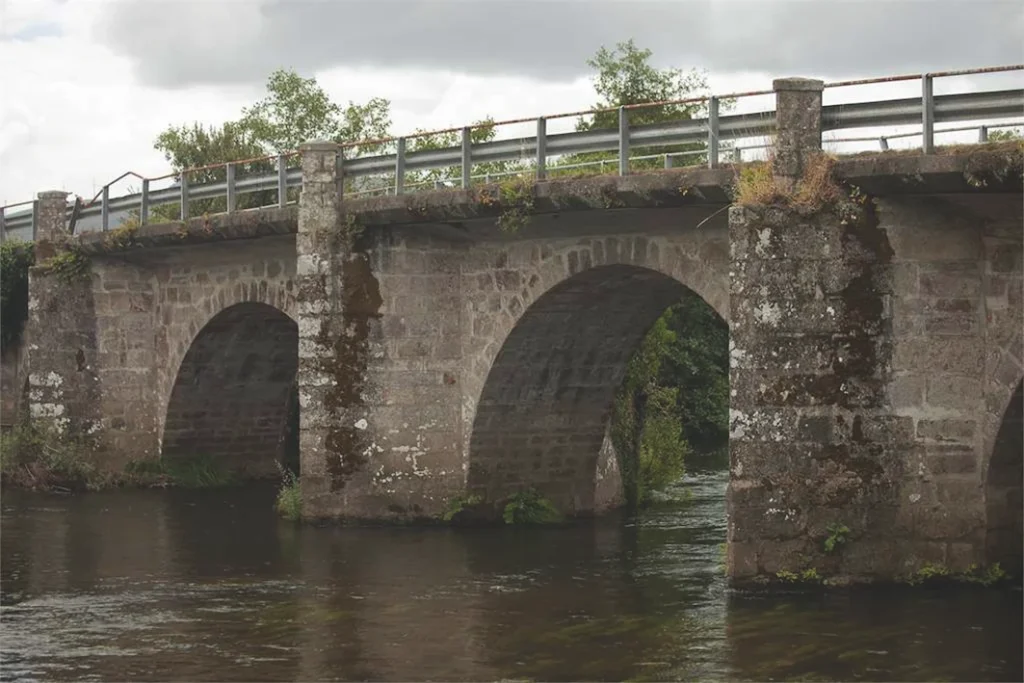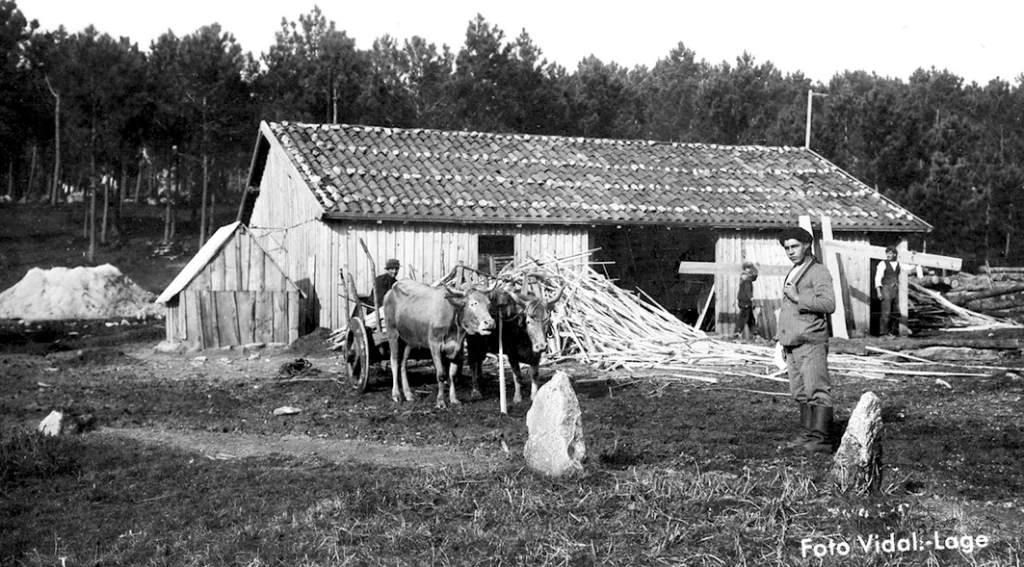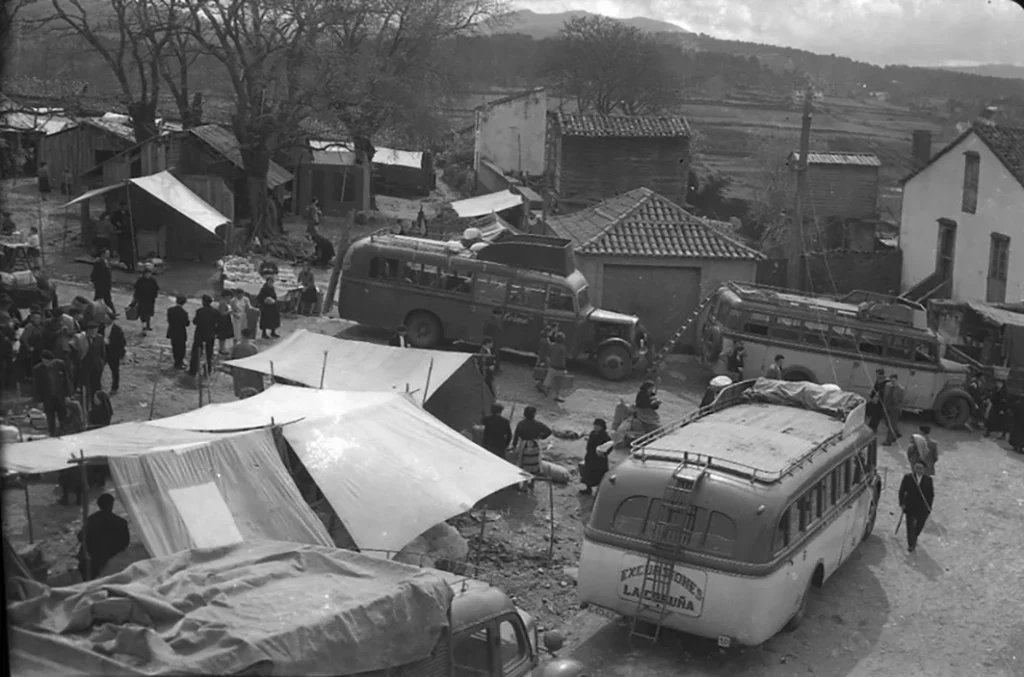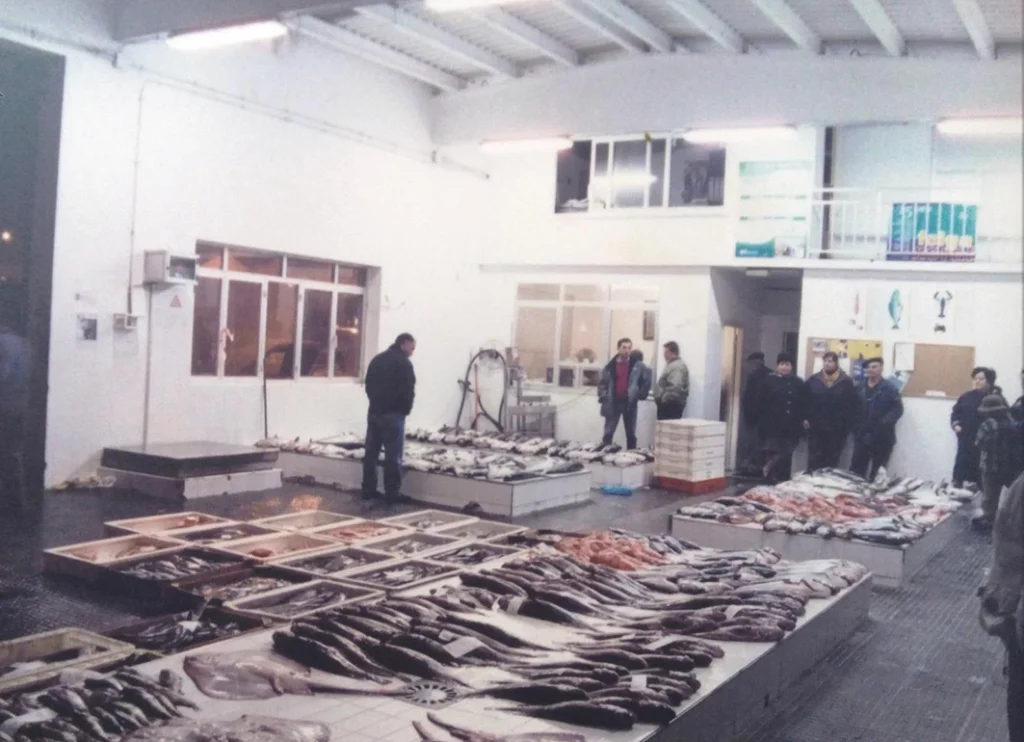This period started with a historic event: the invasion of Spain by Napoleonic troops and the subsequent Peninsular War, which had a major impact on Costa da Morte, especially in the towns of Cee and Corcubión, which were sacked and burnt down by French troops in April 1809.
Two months previously a detachment of French troops had occupied Corcubión with the aim of taking booty to maintain the invading army. Soon after, a defence committee was organised in the town to halt a second offensive, after the town authorities refused to accept the imposition. The alarm was raised and a popular army was recruited under the command of Pedro Lapido, from Morquintián (Muxía), and Juan Domingo Pizpieiro, from O Ézaro (Dumbría), supported by the frigate Endymion, moored in the ría of Corcubión, which supplied arms and ammunition.
Lapido gathered his troops in Ponte Olveira, Baíñas and Vilastose. After finding out that the French had left Santiago and set off towards Corcubión, the defence committee decided to confront them at A Ponte Olveira, which was the only bridge over the river Xallas. When the French troops reached the bridge, they encountered a reduced garrison that offered little resistance, as most of the popular army was in Paizás (Cambeda, Vimianzo) and, when they finally reached the bridge, the French had crossed the river and were heading off to the towns of Cee and Corcubión. Once they arrived, they unleashed a storm of violence on the population. They set fire to the two parish churches and many houses, committing theft, rape and other crimes as they went. This happened on 13 April 1809, but just a few days later they returned and destroyed what little was left. There is little objective information about the French troops’ conduct in Camariñas, but local stories talk of pillaging and many deaths.
After the Peninsular War and the return to the absolutist rule of Ferdinand VII, life soon returned to the same conditions as there had been during the Ancien Regime. The same divisions of hunting reserves and jurisdictions and the appalling conditions of farmers, the most common social class in the region, continued much as before. The desperation of some farmers in the region led some of them to organise groups of bandits, called bandoleros or gavillas and assault the homes of priests, landowners or others with money or goods. The gavilla from Vimianzo was one such gangs in the western part of the region.

Carlism had very little impact on the region, as there were no large monasteries or cities with a powerful clergy. There are records of two Carlist attacks on Carballo. The first took place on 14 January 1838, in which the town was looted and money was stolen, while the second on 7 May of the same year was more violent, with 13 dead and the kidnapping of a liberal judge, José Vázquez de Parga, who was later found dead on a mountain in Arzúa.
There were new divisions of state territory into provinces, judicial districts and municipalities in the 1830s. The reform was carried out by a minister of the regent María Cristina, Javier de Burgos, although some attempts had been made to make such changes under the Cortes of Cádiz and during the Trienio Liberal (three years of liberal national administration).
The same decade also saw the Ecclesiastical Confiscations of Mendizábal, which enabled the State to sell religious properties and goods. The objective was to enable peasant farmers to buy and own land, but plots were auctioned off in large lots and so they were purchased by people who already had considerable funds (nobles and the bourgeoisie).
In Costa da Morte, the property of the monastery of Moraime was auctioned off in 1841 and bought by one J. Méndez, but it then changed hands and became the property of Francisco Leiro, a wealthy man from the same parish. A closer look at the evolution of the population in the Late Modern Period shows a moderate increase from the early 19th c. to the late 20th, but then it came to a standstill and then dropped markedly in the first decades of the 21st c., due to a sharp drop in the birthrate.
The moderate growth that took place throughout the 19th century and a good part of the 20th was caused by emigration. There was a growth in the number of emigrants from 1880 onwards and the process continued until 1930. Many emigrants went to countries in Latin America, mainly Cuba, Argentina, Uruguay and Brazil. The process was halted by the restrictions imposed by these countries because of the Spanish Civil War and the isolation imposed by the Franco regime during the postwar period.
The emigrants established associations in the countries where they settled, such as the Sociedad Agraria y Cultural de los Hijos del Partido de Corcubión, created in Argentina in 1922, which would later be called Asociación Benéfica y Cultural del Partido de Corcubión. The association went on to publish a magazine called Alborada and was highly active in sociocultural and charitable activities related to the places of origin of its members. One of the association’s initiatives was to establish schools to raise the low educational levels that existed in Costa da Morte The aim was to establish a school in each municipality of the Judicial District of Corcubión, but the outbreak of the Civil War halted the project and only four were built: Nemiña (Muxía), Pasarela (Vimianzo), Suarriba (Fisterra) and Estorde (Cee).
Some emigrants acquired fortunes and acted as benefactors in their places of origin, as is the case of Fernando Blanco de Lema, who was born in Cee and later emigrated to Cuba. He donated money for the construction of an important primary and secondary school in his home town. José Carrera Fábregas (born in Corcubión) and Anselmo Villar Amigo (from Malpica) likewise provided the resources necessary to establish schools in the towns where they were born.

Emigration began again towards the end of the 1950s, first to Venezuela and then to countries in Western Europe: Switzerland, Germany, England, France and Holland. There was also interior emigration to regions such as Madrid, Catalonia, the Basque Country and the Canary Islands. Recent years have seen a growing exodus of young people, many of whom are graduates, who, in a climate of economic stagnation in Galicia, seek job opportunities abroad.
Most of the people living and working in Costa da Morte in the 19th and 20th centuries worked in agriculture. Many farmers had no way of owning the land they worked on until the abolition of the regional sharecropping system in 1926. But even when they were able to own them, other factors came into play, such as the small sizes of the farms and the lack of mechanisation, which held back rural development.
The most widely cultivated products continued to be corn, potatoes, wheat, barley, flax, legumes and some fruit and vegetables. Subsistence farming was the norm and not the exception, and low output was the main reason for rural emigration.
Fishing and maritime trade continued to be the main sources of employment in the coastal towns. Sardines, conger, hake and pollack continued to be the most widely caught species.
There were seasons when catches of sardines dropped drastically and created serious crises for fishermen and for the salting factories, who found themselves without work. A crisis of this nature is mentioned in the Dictionary of Pascual Madoz, in the 1840s, when describing the ría of Camariñas. Sardine salting factories were established in the 19th the 20th centuries all along the coast at Quilmas, Brens, Corcubión, Fisterra, Merexo, Camariñas, Camelle, Laxe, Corme and Malpica. Only one of them has remained up to the present day: the Cerdeiras family canning business in Camariñas. Calvo is another large canning factory in Carballo, but it was established by an external company in the 1940s.
Hake and pollack were salted for export, but demand dropped with the influx of large quantities of cheap cod onto the market, which displaced the other two species of salt fish and led to them being sold fresh.
Conger continued to be air dried as it had been for centuries. Air drying racks were used in a number of ports: Muxía, Camelle, Malpica and Caión. The only ones that still exist today are the racks in Muxía, which are unique in Europe and may disappear if they are not protected.
The lack of industrialisation in Costa da Morte was another deficiency in the region, despite the many raw materials produced by agriculture and livestock keeping, fishing and forestry. The carbide factory built in Cee in the early 20th century was one of the first in the region. The same period saw the construction of the first pine wood sawmills, which were established because of the large amounts of raw materials and demand for the product by mines and the construction industry. However, a wood processing industry was not established. Many sawmills were built on the shores of rías or near the coast to facilitate exports by sea. In the 1960s, the UNEMSA factory was built in Erbecedo (Coristanco), where different types of wood fibreboard are made.

The lack of industrialisation in Costa da Morte was another deficiency in the region, despite the many raw materials produced by agriculture and livestock keeping, fishing and forestry. The carbide factory built in Cee in the early 20th century was one of the first in the region. The same period saw the construction of the first pine wood sawmills, which were established because of the large amounts of raw materials and demand for the product by mines and the construction industry. However, a wood processing industry was not established. Many sawmills were built on the shores of rías or near the coast to facilitate exports by sea. In the 1960s, the UNEMSA factory was built in Erbecedo (Coristanco), where different types of wood fibreboard are made.
Costa da Morte has had a poorly developed road network in the region since ancient times. The roads were in a dreadful state in the 19th century. Bridges such as the one at Baio over the river O Porto or the one at Ponteceso over the river Anllóns had almost been in ruins for many years. The most important track was the one from A Coruña to Corcubión and Fisterra, which was converted into a road in the second half of the 19th c. The branch roads that connected this road with the towns of Malpica, Camariñas and Muxía were built shortly after. If the railway line from A Coruña to Corcubión proposed in the early 20th century had been built, economic development of the region would have been very different.
Road links in the region have improved greatly, especially with the city of A Coruña after the construction of the motorway connecting the city with Carballo and the opening of the section of motorway in Costa da Morte between Carballo and Baio, which should now be extended to Cee. Links with Santiago and the south of Galicia are not as good and require roads in better conditions.
Trade in the region was always underdeveloped and almost all commerce was carried out by sea, given that roads were few and in poor conditions. Small commercial ports were located within the rías. Fisterra, Corcubión and Cee, in the ría of Corcubión; Muxía, Camariñas and Ponte do Porto, in the ría of Camariñas; and Laxe, Corme and Ponteceso, in the ría of Corme and Laxe. These ports distributed imports to the interior (wine, oil, iron, lime, salt, etc.) and also exported goods, especially farm produce: wheat, corn, barley, potatoes, legumes, onions, cured or salt fish (sardines, conger and hake), pine wood, lace, and pottery from Buño.
Trade on land was conducted at the fairs held throughout the territory. The largest of these were held at Cee, A Picota, Baíñas, Quintáns, Ponte do Porto, Baio, A Agualada, Anllóns, Leiloio, Verdillo and Paiosaco. The most important fairs were those at Baio, in Terra de Soneira, which was held on the third Sunday of every month in the fields of A Piroga (Bamiro, Vimianzo), from 1741 or possibly earlier, and the fair of Verdillo, in the region of Bergantiños, which was held in the parish of Artes on the fourth Sunday. The fair was then transferred to Carballo in 1941 after several years of protests by the residents and priests of the parishes of Verdillo, Artes and Sofán. Livestock and farm produce were not the only things to be bought and sold at the fairs; a brisk business was also done in cloth, footwear, tools, pottery and many other products.

The most important event to take place in the last century was the Spanish Civil War, which brought severe consequences for Costa da Morte, especially towns where there was an active trade union movement, as is the case with Cee, where there was a carbide factory or the sawmills at A Ponte de Oporto.
The Franco regime savagely repressed Republican and trade union ideals during the war and the postwar period. A lot of information about this period has been brought to light thanks to the research work of the local writer, Luis Lamela García, in his book Crónica de una represión en la “Costa da Morte” (1995), which contains details of military trials, purges, paseos (night-time assassinations) and punishments meted out to many local people during this terrible period. About 110 people went into exile, over 100 were killed and many were imprisoned or fled and hid amongst the crags of Monte Pindo.
After the dictator Franco died, a new period of democracy commenced with the approval of the Constitution of 1978 and the first elections held in the following year. With these new developments, Costa da Morte began to see improvements in the primary sector and more employment in the building and service sectors, but this was not enough to halt emigration to other more developed parts of Spain or to other European countries.

There was a bonanza in coastal fishing during the 1970s and 1980s, but shortly after the fishing grounds showed signs of depletion and the EEC began to impose limitations on catches, which led to a crisis in the sector.
The only modernisation to be seen in the countryside was in livestock farming, and processing industries for the raw materials in the region were not developed, and so not enough jobs were created to employ working population.
At this moment in time the tourist sector is the most dynamic one and is creating the most employment, although much of the work is seasonal. Costa da Morte has more than enough resources to attract quality tourism, for which it has to make a commitment.
Its rich natural heritage that extends throughout the coast and the interior, combined with a splendid historical and cultural heritage, without forgetting its varied and delicious cuisine, make Costa da Norte a region with tremendous potential for tourism in Galicia, as long as its cultural and historical assets are cared for and appreciated.